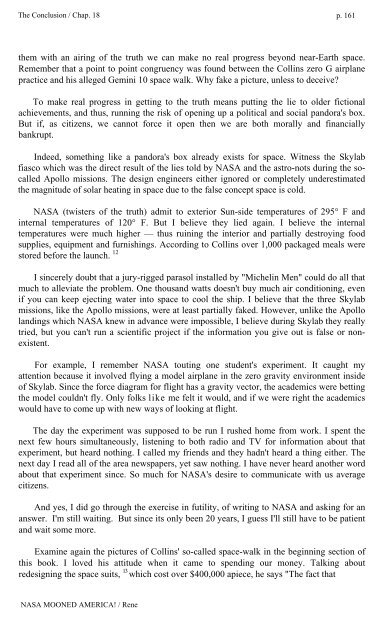Rene-NASA-Mooned-America
Rene-NASA-Mooned-America
Rene-NASA-Mooned-America
Create successful ePaper yourself
Turn your PDF publications into a flip-book with our unique Google optimized e-Paper software.
The Conclusion / Chap. 18 p. 161<br />
them with an airing of the truth we can make no real progress beyond near-Earth space.<br />
Remember that a point to point congruency was found between the Collins zero G airplane<br />
practice and his alleged Gemini 10 space walk. Why fake a picture, unless to deceive<br />
To make real progress in getting to the truth means putting the lie to older fictional<br />
achievements, and thus, running the risk of opening up a political and social pandora's box.<br />
But if, as citizens, we cannot force it open then we are both morally and financially<br />
bankrupt.<br />
Indeed, something like a pandora's box already exists for space. Witness the Skylab<br />
fiasco which was the direct result of the lies told by <strong>NASA</strong> and the astro-nots during the socalled<br />
Apollo missions. The design engineers either ignored or completely underestimated<br />
the magnitude of solar heating in space due to the false concept space is cold.<br />
<strong>NASA</strong> (twisters of the truth) admit to exterior Sun-side temperatures of 295° F and<br />
internal temperatures of 120° F. But I believe they lied again. I believe the internal<br />
temperatures were much higher — thus ruining the interior and partially destroying food<br />
supplies, equipment and furnishings. According to Collins over 1,000 packaged meals were<br />
stored before the launch. 12<br />
I sincerely doubt that a jury-rigged parasol installed by "Michelin Men" could do all that<br />
much to alleviate the problem. One thousand watts doesn't buy much air conditioning, even<br />
if you can keep ejecting water into space to cool the ship. I believe that the three Skylab<br />
missions, like the Apollo missions, were at least partially faked. However, unlike the Apollo<br />
landings which <strong>NASA</strong> knew in advance were impossible, I believe during Skylab they really<br />
tried, but you can't run a scientific project if the information you give out is false or nonexistent.<br />
For example, I remember <strong>NASA</strong> touting one student's experiment. It caught my<br />
attention because it involved flying a model airplane in the zero gravity environment inside<br />
of Skylab. Since the force diagram for flight has a gravity vector, the academics were betting<br />
the model couldn't fly. Only folks like me felt it would, and if we were right the academics<br />
would have to come up with new ways of looking at flight.<br />
The day the experiment was supposed to be run I rushed home from work. I spent the<br />
next few hours simultaneously, listening to both radio and TV for information about that<br />
experiment, but heard nothing. I called my friends and they hadn't heard a thing either. The<br />
next day I read all of the area newspapers, yet saw nothing. I have never heard another word<br />
about that experiment since. So much for <strong>NASA</strong>'s desire to communicate with us average<br />
citizens.<br />
And yes, I did go through the exercise in futility, of writing to <strong>NASA</strong> and asking for an<br />
answer. I'm still waiting. But since its only been 20 years, I guess I'll still have to be patient<br />
and wait some more.<br />
Examine again the pictures of Collins' so-called space-walk in the beginning section of<br />
this book. I loved his attitude when it came to spending our money. Talking about<br />
redesigning the space suits, 13 which cost over $400,000 apiece, he says "The fact that<br />
<strong>NASA</strong> MOONED AMERICA! / <strong>Rene</strong>


